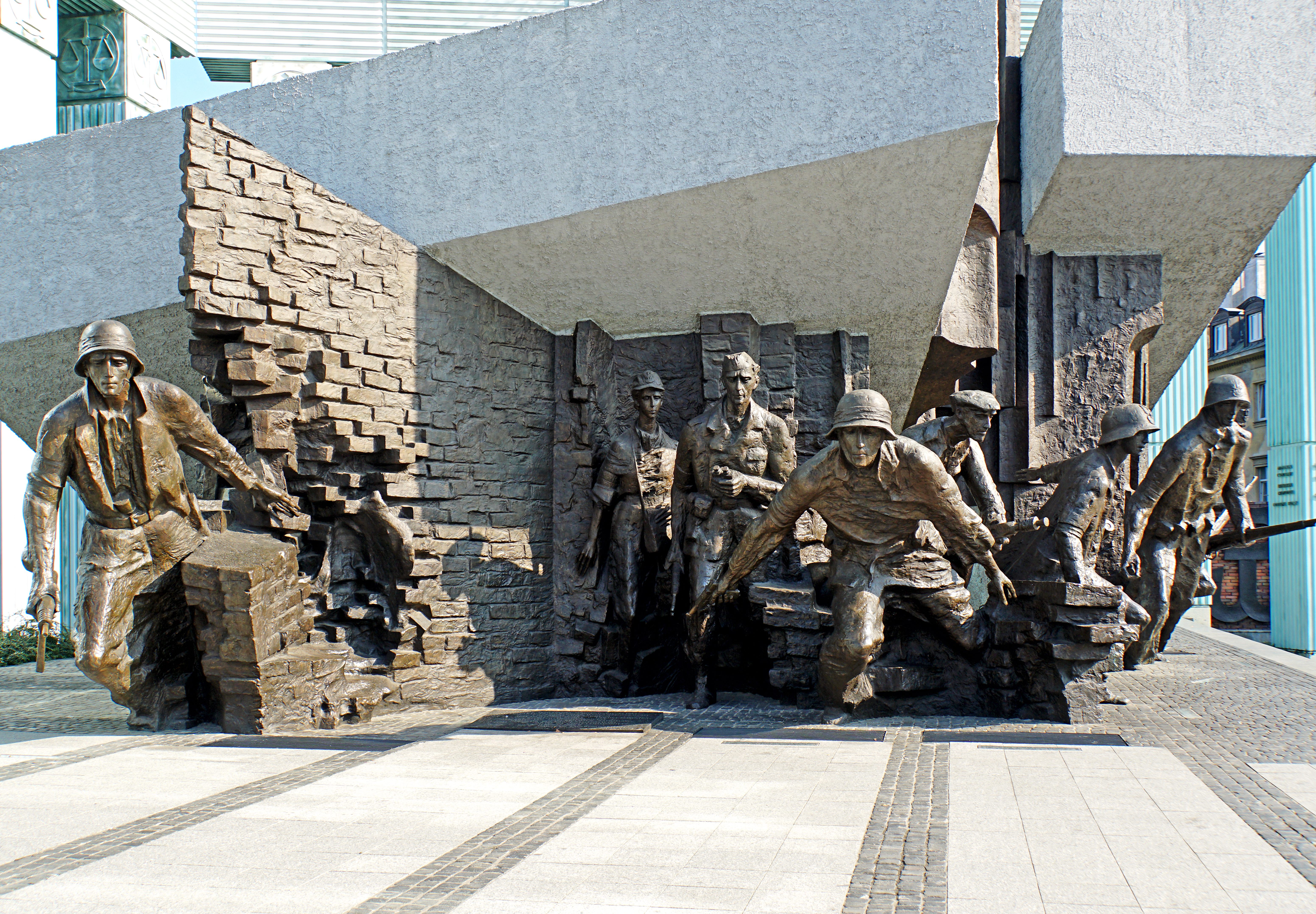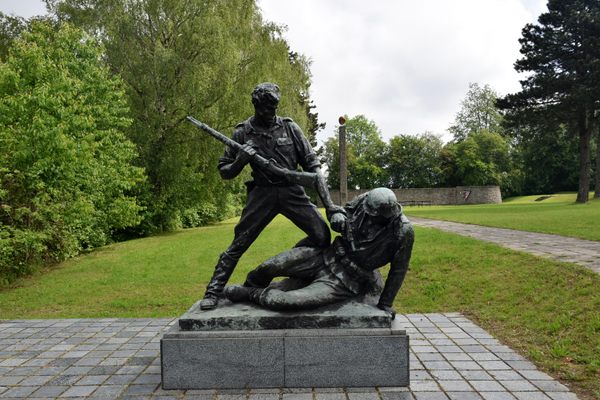7 Overlooked Memorials to the Heroes Who Fought Nazis
These women and men faced terrible danger and deserve to be remembered.

Many of the world’s best statues and memorials honor those who accomplished extraordinary things despite a steep personal cost. Europe is dotted with statues that memorialize the attempts made by desperate people who opposed the Nazis. They did what they could with what they had, and often paid unimaginable prices for their efforts. Their likenesses implore us to remember their actions and consider our own, so that we don’t take the past for granted, idly watch the present, or let the future repeat such atrocities.

Tatyana Markus Memorial
Kyiv, Ukraine
In 1941, when the German Army entered the city of Kyiv, young Tatyana Markus was there to greet them, congratulatory flowers in hand. But instead of graciously handing the flowers over to the triumphant soldiers, she threw them—and the grenades hidden underneath them—at the approaching contingent, killing four Nazi soldiers. Her father threw a second grenade, to prevent them from retaliating. She was able to get away, but he was killed in the ensuing fight.
Later, Markus assumed a fake identity and went undercover. A young operative, she won the confidence of several German army officials and gathered information that helped the Ukrainian rebels resist them. She also worked in a German officers’ mess hall and lured soldiers into isolated areas where she killed them herself.
After the mysterious deaths of so many soldiers, the Gestapo launched an operation to find their killer. Markus was caught in August of 1942 and tortured for information for more than five months, a process which intensified when her Jewish heritage was discovered. But she refused to provide them with any information about her comrades. She was killed in January of 1943 and, according to some accounts, thrown into the notorious Babi Yar ravine, where thousands were massacred by the Nazis.
After the fall of the Soviet Union, a statue of the courageous young woman who gave her life in the fight against the Nazis was unveiled in Babi Yar in 2009, just a few years after she was honored as a “Heroine of Ukraine.”

Denkzeichen Georg Elser
Berlin, Germany
Georg Elser was a carpenter and a member of the leftist Federation of Woodworkers Union. As early as 1933 he opposed the Nazis and refused to perform the Hitler salute; Elser felt the Nazi Party’s potential rule would be a detriment to workers’ rights and a catalyst for war.
In 1938 he traveled to see Hitler’s annual speech at the Bürgerbräukeller beer hall, cased the joint, and came home with a plan to assassinate Hitler. Elser took a job at an armament factory and systematically stole explosives. He eventually amassed 105 blasting cartridges and 125 detonators. He built and tested timed explosives using clock parts and turn signals from cars in a secluded orchard owned by his parents.
At the end of 1939 he moved to a place near the Bürgerbräukeller and spent his nights hiding in the hall, carving out the pillar next to the speaker’s rostrum. He installed a homemade time bomb in the emptied column and left town for Sweden on the morning of November 8. That night, eight high-ranking Nazi officers were killed and 63 were injured when the bomb exploded right on time at 9:20 p.m., exactly 13 minutes after Hitler left the event. His flight had been canceled due to fog, so the event started a half hour early.
Officers found Elser on the Swiss border with wire cutters, notes, sketches, firing pins, and a blank postcard of the interior of the Bürgerbräukeller. He spent his last days a prisoner, and in 1945, shortly before the end of the war, he was killed on Hitler’s orders in the Dachau concentration camp.
The 56-foot sculpture erected in his honor in Berlin is an outline of Elser’s profile, and lights up at night. It was unveiled on November 8, 2011, to coincide with the anniversary of his heroic attempt.

Stjepan Filipović Monument
Valjevo, Serbia
Stjepan Filipvić joined the laborer’s movement in 1937. He spent a year in jail for his association with the anti-fascist group, but his conviction remained. He joined the Communist Party of Yugoslavia in 1940, and by ‘41 he’d been made commander of the Partisans’ Tamnavsko-Kolubarski unit in Valjevo. He was captured by the Axis forces in 1942 and sentenced to death. But even in his final moments, he resisted the Nazi occupation. The Yugoslav communist stood on the gallows in Valjevo, rope around his neck, and threw his fists in the air and shouted out his last words to the onlookers: “Smrt fašizmu, sloboda narodu!” (“Death to fascism, freedom to the people!”).
Stjepan Filipović was declared a National Hero of Yugoslavia in 1949, and in 1960, a 52-foot statue was erected in his honor. The sculptor Vojin Bakic’s monument to Filipović stands in the same defiant pose in the city where he was killed.

Warsaw Uprising Monument
Warsaw, Poland
In August of 1944, an uprising broke out in Warsaw, Poland, which at the time had been occupied by Nazi forces for five years. The Polish resistance had been planning an attack for some time, but they were forced to carry it out much sooner than expected and without help from the Allied forces.
The resistance expected Soviet help to arrive during the 68-day battle, but it never came. Documents are hard to obtain and the motive is unclear. It’s possible the Soviet troops were too tired or the roads were too treacherous to quickly maneuver, or Stalin stopped the aid for fear the uprising might encourage Russian workers to move against his leadership.
By the end of the uprising, the Polish resistance had managed to kill 8,000 Nazi soldiers and wounded around the same number. But as the Nazis razed the city, the resistance deaths had climbed to 16,000 people, and the civilian death toll, including the Jews being hidden by the Polish people, reached as high as 200,000. The Nazis went on to destroy almost 90 percent of the buildings in the area.
A 33-foot-tall bronze sculpture was unveiled in 1989 to commemorate the resistance. It depicts a group of fighters in active combat while running beneath the ruins of a falling building. A smaller structure shows insurgents entering a manhole, which pays tribute to the way the Poles made use of the city’s sewer system.

The Little Insurrectionist
Warsaw, Poland
Hitler and SS leader Heinrich Himmler made the Polish capital city a specific target early on in the war. Their plan of attack was detailed in the horrifically succinct Order for Warsaw: “Every citizen of Warsaw is to be killed including men, women and children. Warsaw has to be leveled to the ground in order to set a terrifying example to the rest of Europe.”
The children of Warsaw were no strangers to the ongoing atrocities, and many young boys in the Polish Underground Scouting, known during wartime as the Gray Ranks, played an integral role in the Warsaw Uprising, mostly carrying messages for the troops, but sometimes donning stolen German helmets and guns and fighting on the front lines.
This statue of a young boy wearing an oversized helmet and holding a German submachine gun is reputed to be modeled after a child soldier called “Antek,” a 13-year-old boy who was killed on August 8, 1944.

Mauthausen Memorial
Marbach, Austria
The Mauthausen Memorial describes itself as “a former crime scene, a place of memory, a cemetery for the mortal remains of thousands of those murdered here and, increasingly, a site of political and historical education.” Between 1938 and 1945, the Mauthausen concentration camp was the center of more than 40 sub-camps and was the main site of persecution by the National Socialist regime on Austrian territory.
The memorial features a museum in the preserved buildings of the center camp. There are three permanent collections, including the “Room of Names,” which features over 81,000 names of those killed at Mauthausen and the surrounding sub camps.
The outside areas feature sculptures that honor the 190,000 people from over 40 different nations who were imprisoned during the camp’s seven years of terror. Memorial sculptures of varying sizes and styles pay homage to the Jewish, French, Dutch, Polish, and other victims of Mauthausen. One particularly striking statue is the Albanian Memorial, which portrays an Albanian resistance fighter standing over a defeated Nazi soldier. He’s about to strike the Nazi in the face with his rifle stock.

Wojtek the Soldier Bear Memorial
Edinburgh, Scotland
A beer-drinking, Nazi-fighting brown bear named Wojtek was an unlikely but beloved member of the 22nd Artillery Transport Company. The Polish 2nd Corps adopted the orphaned bear in Iran in 1943. To bypass a rule that forbade soldiers from bringing pets into theaters of operations, Wojtek was enlisted and accordingly given an official number and the rank of private.
Private Wojtek served with the Poles for the rest of the war, most notably during the pivotal Battle of Monte Cassino, when he voluntarily helped move crates of ammunition. He was so popular among his fellow soldiers that a graphic of a bear carrying an artillery shell became the official emblem of the 22nd Company.
After the war ended, Wojtek was moved to the Edinburgh Zoo. His old Polish brothers-in-arms visited him regularly, as did the scores of new admirers he gained during the remainder of his life.
Unveiled on November 7, 2015, the bronze statue in Princes Street Gardens commemorates not only the much-beloved bear, but also the Polish soldiers who bravely shared the same harrowing journey.



















Follow us on Twitter to get the latest on the world's hidden wonders.
Like us on Facebook to get the latest on the world's hidden wonders.
Follow us on Twitter Like us on Facebook